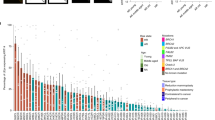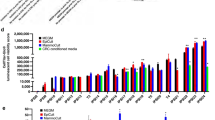Abstract
Senescence and genomic integrity are thought to be important barriers in the development of malignant lesions1. Human fibroblasts undergo a limited number of cell divisions before entering an irreversible arrest, called senescence2. Here we show that human mammary epithelial cells (HMECs) do not conform to this paradigm of senescence. In contrast to fibroblasts, HMECs exhibit an initial growth phase that is followed by a transient growth plateau (termed selection or M0; refs 3,4,5), from which proliferative cells emerge to undergo further population doublings (∼20–70), before entering a second growth plateau (previously termed senescence or M1; refs 4,5,6). We find that the first growth plateau exhibits characteristics of senescence but is not an insurmountable barrier to further growth. HMECs emerge from senescence, exhibit eroding telomeric sequences and ultimately enter telomere-based crisis to generate the types of chromosomal abnormalities seen in the earliest lesions of breast cancer. Growth past senescent barriers may be a pivotal event in the earliest steps of carcinogenesis, providing many genetic changes that predicate oncogenic evolution. The differences between epithelial cells and fibroblasts provide new insights into the mechanistic basis of neoplastic transformation.
This is a preview of subscription content, access via your institution
Access options
Subscribe to this journal
Receive 51 print issues and online access
$199.00 per year
only $3.90 per issue
Buy this article
- Purchase on Springer Link
- Instant access to full article PDF
Prices may be subject to local taxes which are calculated during checkout



Similar content being viewed by others
References
Shay, J. W., Wright, W. E. & Werbin, H. Toward a molecular understanding of human breast cancer: a hypothesis. Breast Cancer Res. Treatment. 25 83–94 (1993).
Hayflick, L. The limited in vitro lifetime of human diploid cell strains. Exp. Cell Res. 37, 614–636 (1965).
Hammond, S. L., Ham, R. G. & Stampfer, M. R. Serum-free growth of human mammary epithelial cells: rapid clonal growth in defined medium and extended passage with pituitary extract. Proc. Natl Acad. Sci. USA 81, 5435–5439 (1984).
Foster, S. A. & Galloway, D. A. Human papillomavirus type 16 E7 alleviates a proliferation block in early passage human mammary epithelial cells. Oncogene 12, 1773–1779 (1996).
Huschtscha, L. I. et al. Loss of p16INK4 expression by methylation is associated with lifespan extension of human mammary epithelial cells. Cancer Res. 58, 3508–3512 (1998).
Kiyono, T. et al. Both Rb/p16INK4a inactivation and telomerase activity are required to immortalize human epithelial cells. Nature 396, 84–88 (1998).
Meyer, K. M., Hess, S. M., Tlsty, T. D. & Leadon, S. A. Human mammary epithelial cells exhibit a differential p53-mediated response following exposure to ionizing or UV light. Oncogene 18, 5792–57805 (1999).
Walen, K. H. & Stampfer, M. R. Chromosome analyses of human mammary epithelial cells at stages of chemical-induced transformation progression to immortality. Cancer Genet. Cytogenet. 37, 249–261 (1989).
Brenner, A. J., Stampfer, M. R. & Aldaz, C. M. Increased p16 expression with first senescence arrest in human mammary epithelial cells and extended growth capacity with p16 inactivation. Oncogene 17, 199–205 (1998).
Dimri, G. P. et al. A biomarker that identifies senescent human cells in culture and in aging skin in vivo. Proc. Natl Acad. Sci. USA 92, 9363–9367 (1995).
Pignolo, R. J., Rotenberg, M. O. & Cristofalo, V. J. Alterations in contact and density-dependent arrest state in senescent WI-38 cells. In Vitro Cell. Dev. Biol. Anim. 30A, 471–476 (1994).
Shay, J. W. & Wright, W. E. Quantitation of the frequency of immortalization of normal human diploid fibroblasts by SV40 large T-antigen. Exp. Cell Res. 184, 109–118 (1989).
Taylor-Papadimitriou, J. et al. Keratin expression in human mammary epithelial cells cultured from normal and malignant tissue: relation to in vivo phenotypes and influence of medium. J. Cell Sci. 94, 403–413 (1989).
Foster, S. A., Wong, D. J., Barrett, M. T. & Galloway, D. A. Inactivation of p16 in human mammary epithelial cells by CpG island methylation. Mol. Cell. Biol. 18, 1793–1801 (1998).
Lansdorp, P. M. et al. Heterogeneity in telomere length of human chromosomes. Hum. Mol. Genet. 5, 685–691 (1996).
van Steensel, B., Smogorzewska, A. & de Lange, T. TRF2 protects human telomeres from end-to-end fusions. Cell 92, 401–413 (1998).
Stampfer, M. R. et al. Gradual phenotypic conversion associated with immortalization of cultured human mammary epithelial cells. Mol. Biol. Cell 8, 2391–2405 (1997).
Karlseder, J., Broccoli, D., Dai, Y., Hardy, S. & de Lange, T. p53- and ATM-dependent apoptosis induced by telomeres lacking TRF2. Science 283, 1321–1325 (1999).
Artandi, S. E. et al. Telomere dysfunction promotes non-reciprocal translocations and epithelial cancers in mice. Nature 406, 641–645 (2000).
Chin, L. et al. p53 Deficiency rescues the adverse effects of telomere loss and cooperates with telomere dysfunction to accelerate carcinogenesis. Cell 97, 527–538 (1999).
Alcorta, D. A. et al. Involvement of the cyclin-dependent kinase inhibitor p16 (INK4A) in replicative senescence of normal human fibroblasts. Proc. Natl Acad. Sci. USA 92, 13742–13747 (1996).
Hara, E. et al. Regulation of p16CDKN2 expression and its implications for cell immortalization and senescence. Mol. Cell. Biol. 16, 859–867 (1996).
Burbano, R. R. et al. Cytogenetics of epithelial hyperplasias of the human breast. Cancer Genet. Cytogenet. 119, 62–66 (2000).
Pandis, N. et al. Chromosome abnormalities in bilateral breast carcinomas. Cytogenetic evaluation of the clonal origin of multiple primary tumors. Cancer 76, 250–258 (1995).
Berg, J. W. & Hutter, R. V. Breast cancer. Cancer 75, 257–269 (1995).
Stoeber, K. et al. Cdc6 protein causes premature entry into S phase in a mammalian cell-free system. EMBO J. 17, 7219–7229 (1998).
Wei, W. & Sedivy, J. M. Differentiation between senescence (M1) and crisis (M2) in human fibroblasts cultures. Exp. Cell Res. 253, 519–522 (1999).
Tlsty, T. D. et al. Potentiation of genomic instability in normal human mammary epithelial cells by an epigenetic event. J. Mammary Gland Biol. Neoplasia (in the press).
Acknowledgements
We thank E. H. Blackburn, I. Herskowitz and J. Li for comments, criticism and reading the manuscript. Stimulating discussion and thoughtful critique were provided by Y. Crawford, G. Whitworth, M. Heiman, M. Springer, D. Crawford, P. Hein and J. Anderson. We thank S. Gilbert for assistance with the figures; P. Ortiz for library support; and G. Williams for MCM2 antibodies. This work was supported by NIH and NIH/NASA grants to T.D.T. and a DOE and NIH grant to M.R.S. C.R.H. is supported by a Howard Hughes Pre-doctoral Fellowship.
Author information
Authors and Affiliations
Corresponding author
Supplementary Information
Rights and permissions
About this article
Cite this article
Romanov, S., Kozakiewicz, B., Holst, C. et al. Normal human mammary epithelial cells spontaneously escape senescence and acquire genomic changes. Nature 409, 633–637 (2001). https://doi.org/10.1038/35054579
Received:
Accepted:
Issue Date:
DOI: https://doi.org/10.1038/35054579
This article is cited by
-
Combining old and new concepts in targeting telomerase for cancer therapy: transient, immediate, complete and combinatory attack (TICCA)
Cancer Cell International (2023)
-
Epigenetic Silencing of p16INK4a gene in Sporadic Breast Cancer
Indian Journal of Surgical Oncology (2023)
-
Tools used to assay genomic instability in cancers and cancer meiomitosis
Journal of Cell Communication and Signaling (2022)
-
Regulation of human telomerase in homeostasis and disease
Nature Reviews Molecular Cell Biology (2020)
-
MYC regulates fatty acid metabolism through a multigenic program in claudin-low triple negative breast cancer
British Journal of Cancer (2020)
Comments
By submitting a comment you agree to abide by our Terms and Community Guidelines. If you find something abusive or that does not comply with our terms or guidelines please flag it as inappropriate.



